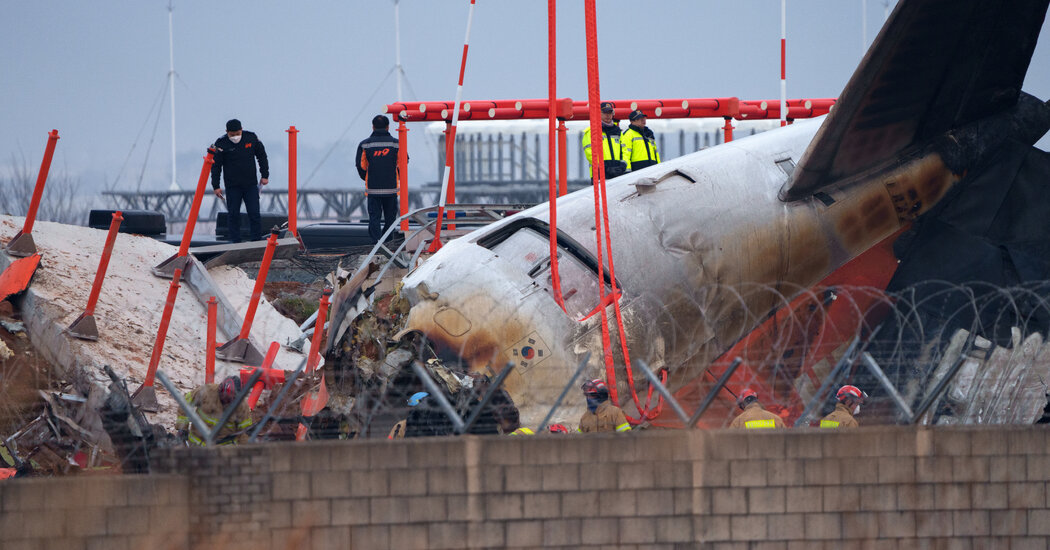The pilots of Jeju Air Flight 2216 signaled three different plans for landing the stricken plane in the minutes before it crashed and killed 179 people in December, according to a partial transcript of their communication with air traffic controllers obtained by The New York Times.
The transcript shows that the pilots reported a bird strike and radioed a mayday call as they approached Muan International Airport in South Korea on the morning of Dec. 29. They said they would turn left, then asked to turn right, intending to approach the airport’s sole runway from the south. When that failed, air traffic controllers asked if they wanted to land from the opposite direction, and the pilots said yes.
The plane landed on its belly, overran the runway and struck a concrete structure that housed navigation aids, bursting into a deadly fireball. Only two people — flight attendants at the very back of the plane, a Boeing 737-800 — survived.
The cause of the disaster, the deadliest plane crash on South Korean soil, is still being investigated, and the exchange between the pilots and the control tower could be a crucial piece of the puzzle. That is because it covers a period of about four minutes during which both of the plane’s flight recorders, known as black boxes, had stopped recording.
The transcript includes no information about the state of the jet’s two engines or its electrical supply, which are intense areas of focus for investigators. It is still unclear why the black boxes went dark or why the plane’s landing gear was not engaged.
The transcript was read out on Saturday to relatives of the victims by a representative of a board that is investigating the crash. The official told them that the readout excluded parts of the conversation to protect the privacy of its participants, according to people who shared it with The Times. Officials have not publicly released the transcript, and the board did not immediately respond to a request for comment.
Multiple investigations, including one by the police, are underway in South Korea into the cause of the accident and factors that might have made it deadlier, like the solid concrete structure at the end of the runway. American and French investigators are assisting in one of the investigations.
Much of what happened on that December morning remains a mystery.
As the plane, which took off from Bangkok, approached Muan in southwestern South Korea, it began its descent, reaching an altitude of about 700 feet before running into trouble.
First came a warning: Air traffic controllers told the pilots to be cautious because there were birds in the area. About a minute later, both of the plane’s black boxes — its flight data recorder and its cockpit voice recorder — stopped recording.
That outage has complicated the investigation. But videos shot by onlookers, a preliminary accident report issued by the Korean authorities, and now the transcript of the pilots’ exchange with the control tower provide some clues.
This is what we know:
Around 8:58 a.m., the pilots reported a bird strike to the tower. “Mayday, mayday,” one of the pilots said. “Going around.”
Authorities later found feathers and blood from migratory ducks known as baikal teals in both of the jet’s engines. Eyewitness videos also recorded a loud bang from the plane’s right engine, which aviation experts have described as a compressor stall or a disruption in the engine’s airflow.
After the mayday call, the control tower told the pilots to “maintain runway heading” and climb to 5,000 feet. The pilots agreed.
That is standard procedure when an aircraft is unable to land, according to Hyoseok Chang, an assistant professor in the department of air transportation and logistics at Hanseo University in South Korea. In such procedures, the aircraft climbs to a safe altitude and waits in a holding pattern.
But seconds after the pilots agreed to that plan, before the airplane could reach 5,000 feet, the control tower pressed them to state their intention. They answered that they would make a left turn and land shortly on Runway 1. (That is professional terminology for approaching the airport’s single runway from the south; Runway 19 refers to approaching it from the north.)
The pilots may have determined that “returning all the way to the holding point and attempting another approach to Runway 1 could cause further issues with the aircraft,” Professor Chang said. The compressor stall observed in videos indicates that there was a problem with at least one of the jet’s engines.
Ten seconds later, the pilots reported that they were unable to land. They asked whether they could “make a right turn and head to Runway 1,” and the tower gave them permission to do so.
The transcript does not explain why this attempt failed, too. But at just after 9:01 a.m., air traffic controllers asked whether the pilots wanted to approach the runway from the north. “Do you wish to land on Runway 19?” the controllers asked.
The pilots said yes, and the tower cleared them to land.
Less than two minutes later, the plane hit the tarmac without its landing gear deployed. It skidded past the end of the runway, slammed into the concrete structure and burst into flames.
It is not clear what the air traffic controllers or the pilots knew about the concrete structure, which housed what is known as an instrument landing system. Under international safety standards, such structures are supposed to be built to collapse on impact, but this one was not.
Agnes Chang contributed reporting.
